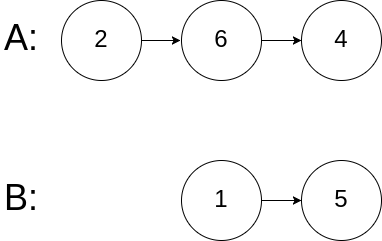题目描述:
Write a program to find the node at which the intersection of two singly linked lists begins.
For example, the following two linked lists:
begin to intersect at node c1.
Example 1:
Input: intersectVal = 8, listA = [4,1,8,4,5], listB = [5,0,1,8,4,5], skipA = 2, skipB = 3 Output: Reference of the node with value = 8 Input Explanation: The intersected node's value is 8 (note that this must not be 0 if the two lists intersect). From the head of A, it reads as [4,1,8,4,5]. From the head of B, it reads as [5,0,1,8,4,5]. There are 2 nodes before the intersected node in A; There are 3 nodes before the intersected node in B.
Example 2:
Input: intersectVal = 2, listA = [0,9,1,2,4], listB = [3,2,4], skipA = 3, skipB = 1 Output: Reference of the node with value = 2 Input Explanation: The intersected node's value is 2 (note that this must not be 0 if the two lists intersect). From the head of A, it reads as [0,9,1,2,4]. From the head of B, it reads as [3,2,4]. There are 3 nodes before the intersected node in A; There are 1 node before the intersected node in B.
Example 3:
Input: intersectVal = 0, listA = [2,6,4], listB = [1,5], skipA = 3, skipB = 2 Output: null Input Explanation: From the head of A, it reads as [2,6,4]. From the head of B, it reads as [1,5]. Since the two lists do not intersect, intersectVal must be 0, while skipA and skipB can be arbitrary values. Explanation: The two lists do not intersect, so return null.
Notes:
- If the two linked lists have no intersection at all, return
null. - The linked lists must retain their original structure after the function returns.
- You may assume there are no cycles anywhere in the entire linked structure.
- Your code should preferably run in O(n) time and use only O(1) memory.
代码:
1 # Definition for singly-linked list. 2 # class ListNode(object): 3 # def __init__(self, x): 4 # self.val = x 5 # self.next = None 6 7 class Solution(object): 8 def getIntersectionNode(self, headA, headB): 9 """ 10 :type head1, head1: ListNode 11 :rtype: ListNode 12 """ 13 if headA is None or headB is None: 14 return None 15 16 pa = headA 17 pb = headB 18 19 while pa is not pb: 20 pa = headB if pa is None else pa.next 21 pb = headA if pb is None else pb.next 22 23 return pa
分析:
代码是基于这样的考虑:给定两根绳子(它们的长度可以相等也可以不相等),已知两条绳子有一个交点,甲沿着A绳走,乙沿着B绳走,问他们在何处相遇?
思路是另取两根绳子A' 和 B' ,绳子的长度为: A' = B, B' = A,将A'接在A的后面,B'接在B的后面,甲走到A绳的尽头后继续在A'上走,乙同理。
则此时甲和乙走的总长度是相等的,且他们的速度一样,那么他们必会相遇,相遇的地方就是原来的两条绳子相交的地方。



